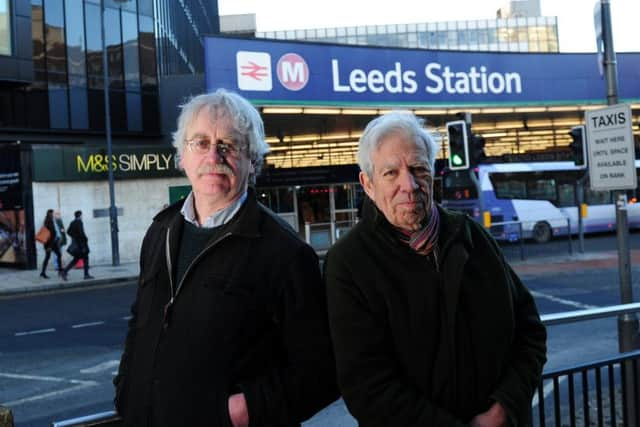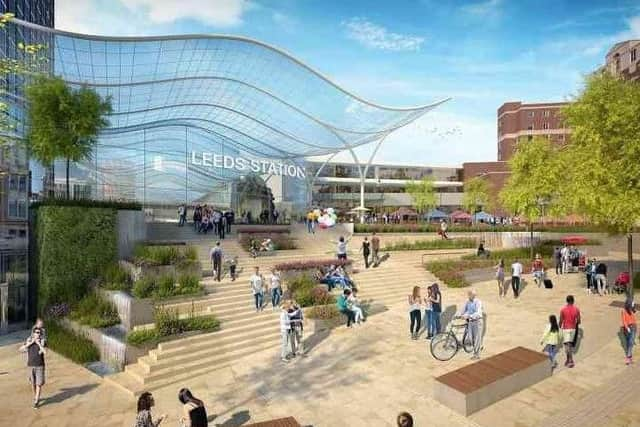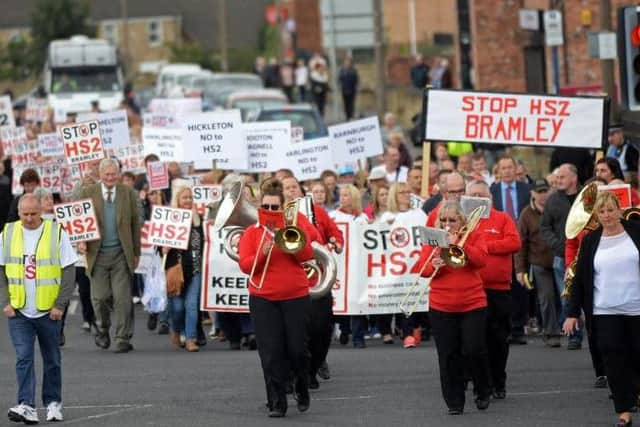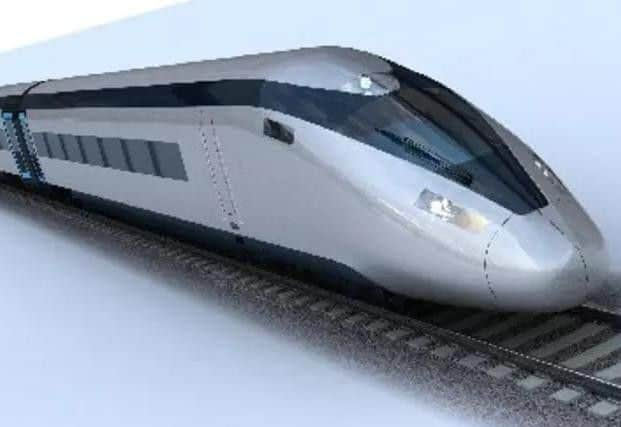Maverick railway engineers from Yorkshire hoping to stop HS2 in its tracks
As David and Goliath battles go, Colin Elliff and Quentin Macdonald would have struggled to choose a more mighty opponent. The two railway engineers are taking on HS2 Ltd, the Government-sponsored company which is charged with delivering the country’s new high-speed railway network with the support of a £56bn budget and 1,500 members of staff.
But after a decade of hard work of drawing up their alternative high-speed rail plans, a process which has seen Elliff travel an estimated 25,000 miles around the country to examine the locations where he believes a superior route could pass through and promote the plan at meetings and conferences, the pair are fired up by a passionate belief that their scheme would both save the taxpayer billions while also providing better connections and faster journey times.
Advertisement
Hide AdAdvertisement
Hide AdHowever, despite drawing up a fully mapped design at 1:25,000 scale and detailed reports running for hundreds of pages for what they call High Speed UK (HSUK), the pair say they have struggled to get a hearing for their ideas from the Government, despite widespread concerns about the spiralling costs of HS2 and its impact on communities up and down the country.


Elliff says: “There is certainly a potential credibility issue when two mavericks attempt to tell an entire industry and Government machine that they’ve got it all wrong. But given that only HSUK meets either the HS2 project’s aim of ‘hugely enhanced capacity and connectivity’ or the much more specific journey time targets of the Northern Powerhouse, then I would strongly suggest that it’s everybody else whose got the credibility problem.”
The pair, who have more than 90 years of railway industry experience between them, both used to work for British Rail and moved into consultancy work before coming up with plans in 2008 which predated HS2 and were originally known as ‘High Speed North’ and eventually became HSUK. Elliff, from Harrogate, is the driving force behind the designs while Macdonald, a former City of York councillor, is the “ideas” man helping to generate publicity for the proposals.
The core route of their proposals would run parallel to the M1 on four tracks between London and Sheffield, continuing up to Leeds and York and on to Scotland. There would also be a trans-Pennine spur from Sheffield to Manchester and Liverpool. In Yorkshire, it would see new stations built in Sheffield and Bradford but operate from existing other city centre stations in the rest of the county.
Advertisement
Hide AdAdvertisement
Hide AdHS2 was initially announced back in 2009 as a way of connecting London to the West Midlands before going on to major cities in the north and Scotland. In June 2014, then-Chancellor George Osborne launched the ‘Northern Powerhouse’ concept by saying that “much more” needed to be done to connect northern cities than was planned through HS2, leading to the establishment of the ‘HS3’ concept. But Elliff and Macdonald say the need for HS3 highlights the shortcomings of HS2 and is in stark contrast with their long-held proposals for a true national high-speed rail network.


The original High Speed North proposal was launched in 2008 and supported by 24 councils in London and the South-East who believed high-speed rail would reduce the demand to expand Heathrow by providing a better alternative to short-haul flights around the UK. In 2013, High Speed North became HSUK to reflect its increased ambitions to create an intercity rail network across the whole country.
Elliff believes the arrival of high-speed rail provides an historic opportunity to rebalance the nation’s economy but thinks the current plans for HS2 do not achieve this. “I firmly believe with HS2, we will get a more London-centric economy. If they had designed HS2 right in the first place, you wouldn’t need HS3 as a separate concept. The HS2 routes were designed with no thought for northern connectivity. Now they are trying to retrofit it on. Our routes are perfectly aligned and meet every requirement of the Northern Powerhouse concept.”
He says making the idea of better connecting major northern cities through HS3 work alongside HS2 has been further complicated by revised HS2 plans which have pushed the route through Yorkshire east towards Barnsley and Doncaster after the idea of a Meadowhall station was scrapped.
Advertisement
Hide AdAdvertisement
Hide AdElliff admits it is a challenge proving the credibility of his ideas but firmly believes they stand up to scrutiny. “In the nine to ten years I have been involved in this, nobody has told me ‘You have got it wrong because of A, B and C and if you understood it correctly, you would understand why HS2 is doing it right’. That conversation has never happened.”


But he says it has been “impossible so far” to get his proposals looked at in detail by decision makers. “It would knock everything they have been doing for the last seven or eight years into the dustbin. The only way they can sleep at night is to find some way of justifying what they have done so far.”
One of the proponents of HSUK was former Leeds MP Greg Mulholland. Last year, he asked Transport Secretary Chris Grayling why the Government had not properly examined HSUK’s proposals, which he said were “£20 billion cheaper and far more environmentally friendly”. But Mr Grayling responded that he was “not in favour of turning the clock back” and delaying the arrival of high-speed rail.
The HSUK plans have also been supported by the Yorkshire Against HS2 campaign group, which has written to Transport for the North to highlight what it considers to be the “superior performance” of it compared to the current official plans.
Advertisement
Hide AdAdvertisement
Hide AdElliff says despite HS2 spending around £2bn on preparations so far, he does not accept it is too late to change course, especially as his project is estimated to cost much less to complete. “If somebody is going to buy a car that doesn’t work for £7,000 or a car that does for £5,000, which is better? The reason I’m doing this is I believe in the concept of public service and pushing concepts forward for the public good. Nothing that we are saying is going to go away. The longer they choose to ignore the evidence, the more public money they are wasting.


“I joined the railways to make a difference and I’ve come up with a system to make the network better. If you paid a consultant to do what I have done, it would be costing millions and millions of pounds.
“It is our one chance with high-speed rail to properly connect the nation. The Northern Powerhouse concept is brilliant but we want to make sure all our cities are well connected to each other.
“We are only two people but we believe we deserve a hearing. If we had a fraction of the resources that HS2 do at our disposal, we could deliver in a fraction of the time. I’m not going to let this one go until somebody proves me wrong. We have got to start getting the debate going.”
HS2 says its Yorkshire route is ‘best solution’
Advertisement
Hide AdAdvertisement
Hide AdHS2 says its route through Yorkshire offers “the best overall solution for the region”.
A spokesman said: “HS2 will deliver major benefits to the Yorkshire region. It is a once in a lifetime opportunity to dramatically improve journeys between the Midlands and the North, and London, boosting capacity, improving connectivity and helping to rebalance the national economy. It is also becoming integral to local plans to drive business growth, create jobs and secure investment years before it arrives.


“The design of HS2 is being undertaken with world leading engineering expertise in high speed rail and infrastructure planning.
“The first phase of the project from London to Birmingham was scrutinised over three years through Parliament and received majority backing from MPs at a ratio of 9:1 at each stage of voting.
Advertisement
Hide AdAdvertisement
Hide Ad“When looking at passenger demand, connectivity, topography, urban density, environmental impacts and cost, our analysis shows that the HS2 route through Yorkshire continues to offer the best overall solution for the region and the country. The same level of scrutiny and diligence in design will be applied as we continue to develop the Birmingham to Leeds route prior to submission of the hybrid Bill in 2019.”
The Department for Transport said the proposals put forward by HSUK were similar to alternative plans put forward by HS2 Ltd in 2010 which were rejected.
A DfT spokesperson said: “HS2 will become the backbone of our national rail network – helping us build a Britain fit for the future, boosting jobs and growth and improving vital links between some of our country’s biggest cities.
“We considered alternative shapes to the high speed network, including those put forward by High Speed UK, however the Y-shape was chosen because it can provide better capacity, connectivity and journey times.
“We are keeping a tough grip on costs and the project is on time and on budget at £55.7bn.”